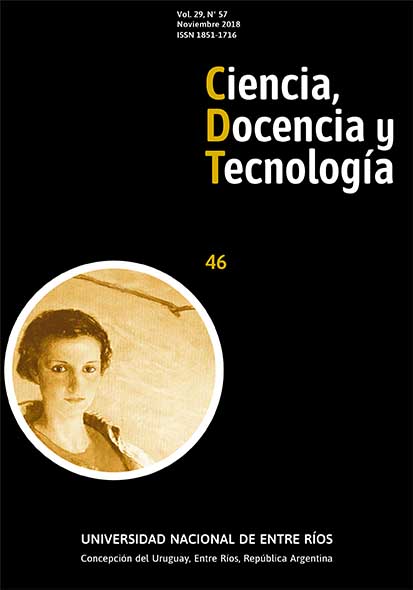Resumo
En la actualidad se habla mucho sobre las TIC, algunos tienden a ser tecnófilos, se consideran devotos y defienden su incorporación en la enseñanza. Por otra parte, hay escépticos de las bondades que éstas ofrecen, las pintan como “riesgosas”. Así pues, no podemos olvidar que toda innovación posee cierta dualidad, la cual no es ajena a las TIC, además de ser una contribución al progreso tecnocientífico en la vida humana, no escapan a los problemas que han desvelado los supuestos éticos y morales que constituyen la base de nuestra sociedad actual. Por ello, en esta investigación se pretende indagar sobre los usos que hacen los estudiantes de las TIC en sus contextos cotidianos, en especial el académico. Se realizó un estudio exploratorio, la información se obtuvo de 92 estudiantes de educación media y se encontraron problemas tecnoéticos que han de ser intervenidos puesto que afectan relaciones sociales y escolares.
Referências
Adell, J. (1998). Nuevas tecnologías e innovación educativa. Organización y gestión educativa, (1), 3–7.
Bunge, M. (1977). Towards a Technoethics. Minist, 96-107.
Cabero, J. (1998). Impacto de las nuevas tecnologías de la información y la comunicación en las organizaciones educativas. Lorenzo, M. y otros (coords): Enfoques en la organización y dirección de instituciones educativas formales y no formales, 197–206.
Cabra-Torres, F., & Marciales-Vivas, G. (2011). Internet y pánico moral: revisión de la investigación sobre la interacción de niños y jóvenes con los nuevos medios. Universitas Psychologica, 10(3), 855–865.
Cortés, P. P. A. (2005). Las preconcepciones sobre la tecnoética en los adultos. Revista Mexicana de psicología, 22(2), 541–552.
ECPAT International. (2012). Riesgos y vulnerabilidad en línea. Latinoamérica.
Flores, F. J. (2011). Por un uso seguro y saludable de Internet, la telefonía móvil y los videojuegos - Por una ciudadanía digital responsable. Recuperado 19 de marzo de 2016, a partir de http://www.pantallasamigas.net/proteccion-infancia-consejos-articulos/sexting-una-practica-de-riesgo.shtm
Londoño, D. M. I. (2014, marzo 17). Ciberbullying o Acoso Cibernético y La Ley 1620 en Colombia. Recuperado a partir de http://blogs.colombiadigital.net/digiapuntes/ciberbullying-o-acoso-cibernetico-y-la-ley-1620-en-colombia/
Luppicini, R. (2009). The emerging field of technoethics. Handbook of research on technoethics, 1–19.
Mera, A. (2014, junio 22). El ciberacoso, un fenómeno que crece a la velocidad de Internet. Recuperado 16 de julio de 2016, a partir de http://www.elpais.com.co/elpais/cali/noticias/ciberacoso-fenomeno-crece-velocidad-internet
MinTIC. (2009). Ley 1341 de 2009: Ley TIC. Recuperado a partir de http://www.mintic.gov.co/portal/604/w3-article-3707.html
MinTIC. (2012). En TIC confío. Bogotá.
Murcia, G. J. (2014, octubre 16). Uso saludable de internet (internet también puede ser saludable) [online]. Recuperado 25 de mayo de 2016, a partir de http://goo.gl/DF55Zx
Panizo, G., Victoria. (2011). El ciber-acoso con intención sexual y el child-grooming. Quadernos de criminología: revista de criminología y ciencias forenses, (15), 22–33.
Rosell, M. C., Sánchez-Carbonell, X., Jordana, C. G., & Fargues, M. B. (2007). El adolescente ante las tecnologías de la información y la comunicación: internet, móvil y videojuegos. Papeles del Psicólogo, 28(3), 196-204.
Sampieri, R. H., Collado, C. F., Lucio, P. B., & Pérez, M. de la L. C. (2010). Metodología de la investigación (Quinta Edición). México: McGraw-Hill México. Recuperado a partir de http://www.univo.edu.sv:8081/tesis/021552/021552_Cap3.pdf
Sierra, G. L. I. (2009). Alcances de una ética en el ciberespacio o el «giro» hacia una «ética floreciente». Signo y Pensamiento, XXVIII(55), 92-107.
UNESCO. (2006). Ética de la Ciencia y la Tecnología. Recuperado a partir de http://www.unesco.org/bpi/pdf/memobpi44_ethics_es.pdf
UNICEF. (2014). Grooming: guía práctica para adultos. Recuperado a partir de http://www.unicef.org/argentina/spanish/guiagrooming_2014.pdf
UNICEF. (2016). Innovaciones con TICS. Recuperado a partir de http://www.unicef.org/argentina/spanish/education_25411.htm
Vanguardia Liberal. (2012). Colombia es uno de los países con mayores cifras de «matoneo». Recuperado a partir de http://www.vanguardia.com/actualidad/colombia/148157-colombia-es-uno-de-los-paises-con-mayores-cifras-de-matoneo
Vila, I., & Casares, R. (2009). Educación y sociedad. Una perspectiva sobre las relaciones entre la escuela y el entorno social. Cadernos de Educação, 57.

Este trabalho encontra-se publicado com a Licença Internacional Creative Commons Atribuição-NãoComercial-CompartilhaIgual 4.0.
Direitos de Autor (c) 2017 Willy Jharinton Vivas

